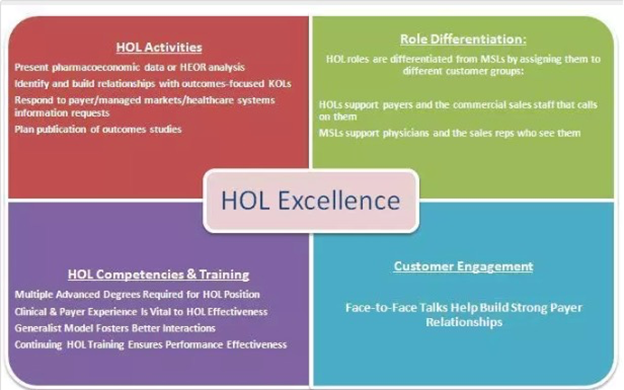Health Outcomes Liaison – Managing Relationships with Payors

The job of a Medical Science Liaison (MSL) comes with an amazing variety of responsibilities. In addition, to building and maintaining relationships with key opinion leaders, MSLs are increasingly tasked with working as the scientific/medical interface to payor organizations.
However, the paradigm shift currently happening in the healthcare industry which is defocusing the fee-for-service healthcare model in favor of evidenced-based approaches and value-based pricing has led to the creation of a new type of “liaison” focused entirely on communicating with payor organizations: the Health Outcomes Liaison (HOL).
HOLs – The New Kids on the Block
The role of an HOL is newer, less established and recognized than that of an MSL. A 2018 study shows that about 56% of the pharma companies have a dedicated HOL team with almost 80% of the them being among the top 20 pharma companies.
So, what exactly are the responsibilities of a health outcomes liaison? Just like their MSL colleagues, they serve as trusted experts, but while MSLs focus on communicating scientific and medical information about a product, an HOL’s focus is on communicating a product’s value proposition and health outcome data to payors. Presenting pharmaeconomic data is therefore one of the key responsibilities of HOLs.
Other main responsibilities include:
- understanding the payors and the overall payor landscape and staying up to date on changes and reforms
- conducting discussions and answer information requests from key opinion leaders in the payor community
- planning and conducting health outcomes research and studies as well as publishing and presenting those data
- providing internal information and training on health outcomes issues to internal stakeholders, specifically MSLs and the account management teams
MSL or HOL: Some Confusion Remains
Being the new kid on the block is never easy and HOLs are sometimes still met with confusion, especially around the question where exactly the role of MSLs ends and that of HOLs begins. The two roles, indeed, have a lot in common and in terms of responsibilities as well as approach.
Like their MSL colleagues, HOLs are subject matter expert committed to presenting accurate data that is free of commercial bias and not focused or incentivized by commercial outcomes. For this reason the majority of HOLs are, like MSLs, members of their company’s medical affairs group.
Similar to MSLs, those HOLs who have a comprehensive understanding of their field of expertise rather than a narrow focus on their portfolio and are able to provide information that extends beyond product-specific data, provide the most value to payors.
Since HOLs are a recent addition to medical affairs department their teams are generally small and so HOLs tend to be generalists rather than specialists.
Payors seem to favor this generalist approach as well because they prefer to have one point of contact that can provide all of the pharmaeconomic information they require over having to deal with several.
The main difference between HOLs customer-facing groups such as key account managers and particularly MSLs, lies less in their job duties and responsibilities and more in the customer group they are working with: HOLs focus primarily on supporting payors while MSLs support physicians.
HOL Internal Stakeholders
A key part of a HOLs job is to work with internal stakeholders such as the market access and medical science liaison teams and to provide information and training on health outcomes issues.
The role of health outcomes liaison is fairly new and the responsibilities of this function will undergo changes as it matures. Given the changes in the healthcare system towards value-based models, HOLs are likely to see their importance increase as they move from providing cost-benefit analysis for a specific drug to analyzing the healthcare environment more holistically to come up with recommendations that lead to better patient outcomes while simultaneously reducing cost.


 HCP Universe
HCP Universe Trial Landscape
Trial Landscape